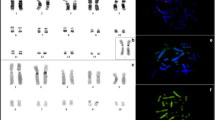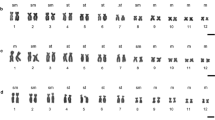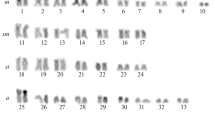Abstract
Kayotypes of four neotropical teiid lizard species (Tupinambinae) were herein studied after conventional as well as silver staining and CBG-banding: Crocodilurus amazonicus (2n = 34), Tupinambis teguixin (2n = 36), Tupinambis merianae and Tupinambis quadrilineatus (2n = 38). The karyological data for T. quadrilineatus as well as those obtained using differential staining for all species were unknown until now. The karyotypes of all species presented 12 macrochromosomes identical in morphology, but differed in the number of microchromosomes: 22 in C. amazonicus, 24 in T. teguixin and 26 in T. quadrilineatus and T. merianae. The Ag-NOR located at the secondary constriction at the distal end of pair 2 is shared by all species, contrasting with the variability observed for this character in species of the related Teiinae. CBG-banding revealed a species-specific pattern in T. quadrilineatus with conspicuous interstitial C-blocks at the proximal region of the long arm of pair 4 and the whole heterochromatic short arm of pair 6. The karyological data reported here corroborates the relationship hypothesis obtained for Tupinambis based on molecular characters. T. teguixin presents the putative ancestral karyotype for the genus with 2n = 36 whereas T. merianae and T. quadrilineatus exhibit 2n = 38, due to an additional pair of microchromosomes.



Similar content being viewed by others
References
Ávila-pires TCS (1995) Lizards of Brazilian Amazônia (Reptilia: Squamata). Zoologische Verhandelingen, Leiden 299:3–706
Beçak ML, Beçak W, Denaro L (1972) Chromosome polymorphism, geographical variation and karyotypes in Sauria. Caryologia 25:313–326
Bertolotto CEV, Pellegrino KCM, Rodrigues MT, Yonenaga-Yassuda Y (2002) Comparative cytogenetics and supernumerary chromosomes in the Brazilian lizard genus Enyalius (Squamata, Polychrotidae). Hereditas 136:51–57
Capula M, Lapini L, Capanna E (1989) The karyotype of Lacerta horvathi (Reptilia, Sauria, Lacertidae). Genetica 79:11–16
Cardone A, Capriglione T, Odierna G, Redi CA, Garagna S (1990) Genomic intraspecific variations in some populations of Podarcis s. sivicula. In: Olmo E (ed) Cytogenetics of Amphibians and Reptiles. Birkhäuser Verlag, Berlin. pp. 247–254
Denton R, O’Neill R (1995) Prototeius stageri, gen.et sp. Nov., a new Teiid lizard from the upper cretaceous marshalltown formation of New Jersey, with a preliminary phylogenetic revision of the Teiidae. J Vertebr Paleontol 15(2):235–253
De Smet WHO (1981) Description of the orcein stained karyotypes of 36 lizard species (Lacertilia, Reptilia) belonging to the families Teiidae, Scincidae, Lacertidae, Cordylidae and Varanidae (Autarchoglossa). Acta Zoological et Pathologica Antverpiensia 76:73–118
Estes R, Queiroz K, Gauthier J (1988) Phylogenetic relationships within Squamata. In: Estes E, Pregill G (eds) Phylogenetic relationships of the lizard families. Stanford, California, pp. 119–281
Fitzgerald LA, Cook JA, Aquino AL (1999) Molecual phylogenetics and conservation of Tupinambis. Copeia 4:894–905
Fry BG, Vida N, Norman J, Vonk FJ, Scheib H, Ramjan R, Kuruppu S, Fung K, Hedges SB, Richardson WC, Hodgson WC, Ignjatovic V, Summerhayes R, Kochva E (2006) Early evolution of the venom system in lizard and snakes. Nature 439:584–588
Gorman GC (1970) Chromosomes and the systematics of the family Teiidae (Sauria: Reptilia). Copeia 2:230–245
Gorman GC (1973) The chromosomes of the Reptilia, a cytotaxonomic interpretation. In: Chiarelli AB, Cappana E (eds) Citotaxonomy and Vertebrate Evolution. Acad Press, New York, pp. 349–424
Günther A (1871) Description of a new species of Tejus (Tejus rufescens) from Mendoza. In Longmans, Green, Reader, Dyer (eds) Scientific Meetings of the Zoological Society of London. Messrs, London, pp. 541–543
Kasahara S, Yonenaga-Yassuda Y, Rodrigues MT (1987) Geographical karyotypic variations and chromosome banding patterns in Tropidurus hispidus (Sauria, Iguanidae) from Brazil. Caryologia 40:43–57
Kasahara S, Pellegrino KCM, Yonenaga-Yassuda Y, Rodrigues MT (1996) Comparative cytogenetic studies of eleven species of the Tropidurus torquatus group (Sauria; Tropiduridae), whith banding patterns. Hereditas 125:37–46
Linnaeus C (1758) Systema naturae per regna tria naturae, secundum classes, ordines, genera, species, cum characteribus, differentiis, synonymus, locis. 10th ed., tomus I. Stocholm
Lönnberg E, Andersson G (1910) A new lizard and a new frog from Parana. Arkiv For Zoologi 6:1–11
Manzani PR, Abe S (1997) A new species of Tupinambis Daudin, 1802 (Squamata, Teiidae) from central Brazil. Boletim Museu Nacional Rio de Janeiro Zoologia 1–10
Olmo E (1986) Reptilia. In: John B (ed) Animal cytogenetics. Berlin, Gebruder, Borntraeger
Olmo E, Odierna G, Capriglione T, Cardone A (1990) DNA and chromosome evolution in lacertid lizards. In: Olmo E (ed) Cytogenetics of amphibians and reptiles. Birkhäuser Verlag, Berlin, pp. 181–204
Pellegrino KCM, Yonenaga-Yassuda Y, Rodrigues MT (1994) Cytogenetic studies in six species of Tropiduridae (Sauria). Revista Brasileira de Genética 17:401–408
Péres AKJr., Colli GR (2004) The taxonomic status of Tupinambis rufescens and T. duseni (Squamata: Teiidae), with a redescription of the two species. Occasional papers, Sam noble Oklahoma museum of natural history 15:1–12
Presch W (1974) Evolutionary relationshiphs and biogeography of the macroteiid lizards (Family Teiidae, Subfamily Teiinae). Bull South Cal Acad Sci 73:23–32
Reeder TW, Cole CJ, Dessauer HC (2002) Phylogenetic relationships of whiptail lizards of the genus Cnemidophorus (Squamata: Teiidae): a test of monophyly, reevaluation of karyotypic evolution, and review of hybrid origins. Am Mus Novit 3365:1–61
Rieppel O (1980) The phylogeny of anguinomorph lizards. Birkhauser Verlag, Switzerland
Santos RML, Pellegrino KCM, Rodrigues MT, Yonenaga-Yassuda Y (2007) Differential staining and microchromosomal variation in karyotypes of four Brazilian species of Tupinambinae lizards (Squamata: Teiidae). Genetica 131:231–240
Townsend TM, Larson A, Louis E, Macey R (2004) Molecular Phylogenetics of Squamata: the position of Snakes, Amphisbaenians, and Dibamids, and the root of the Squamata tree. Syst Biol 53 (5):735–757
Vanzolini PE, Valencia J (1965) The genus Dracaena, with a brief consideration of macroteiid relationships (Sauria, Teidae). Arquivos de Zoologia 13:7–35
Veronese LB, Freitas TRO, Krause L (2003) Cytogenetic studies of four Brazilian species of lizards (Squamata, Teiidae). Caryologia 56(1):107–114
Vidal N, Hedges SB (2005) The phylogeny of squamate reptiles (lizards, snakes, and amphisbaenians) inferred from nine nuclear protein-coding genes. Evolution 328:1000–1008
Yonenaga-Yassuda Y, Kasahara S, Chu TH, Rodrigues MT (1988) High-resolution RBG-banding pattern in the genus Tropidurus (Sauria, Iguanidae). Cytogenet Cell Genet 48:68–71
Yonenaga-Yassuda Y, Mori L, Chu TH, Rodrigues MT (1996) Chromosomal banding patterns in the eyelid-less microteiid radiation: Procellosaurinus and Vanzosaura (Squamata, Gymnophthalmidae). Cytogenet Cell Genet 74:203–210
Acknowledgements
The authors are grateful to Vinícius Xavier da Silva, Gabriel Skuk, Dante Pavan, José Manuel Martins and Felipe Curcio for help in field, and to Renata C. Amaro-Ghilardi, Carolina E. V. Bertolotto and Cyntia Esteves de Lima for technical assistance. This work was supported by Conselho Nacional de Desenvolvimento Científico e Tecnológico (CNPq) and Fundação de Amparo à Pesquisa do Estado de São Paulo (FAPESP).
Author information
Authors and Affiliations
Corresponding author
Rights and permissions
About this article
Cite this article
dos Santos, R.M.L., Rodrigues, M.T., Yonenaga-Yassuda, Y. et al. Differential staining and microchromosomal variation in karyotypes of four Brazilian species of Tupinambinae lizards (Squamata: Teiidae). Genetica 134, 261–266 (2008). https://doi.org/10.1007/s10709-007-9233-7
Received:
Accepted:
Published:
Issue Date:
DOI: https://doi.org/10.1007/s10709-007-9233-7




